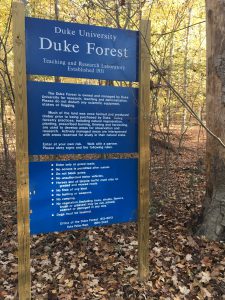We like to ward off the beginning of the work-week blues with a thought about life on the outside.
Today, I get to open an early Christmas present, a present that’s been sitting under the tree for three months.
Duke Forest.
In September, I relocated my office to Durham, to a location based in part on its nearness to our new home in Hillsborough, in part based on the reasonable lease. A third perk surfaced within a few days when I realized I was within a five-minute drive of Hollow Rock Nature Park, Sandy Creek Park, and Duke’s Al Buehler Cross-Country Trail, perfect lunchtime escapes. It was a few more days before I realized I was also within five minutes of at least a half dozen access points to Duke Forest, off NC 751 and Cornwallis Road. On my first visit, to Gate 11, I was met by an asterisk:
Closed to the Public
Monday through Friday
Sep 26 — Dec 16, 2016
For the Deer Herd
Reduction Program
Rats.
Now in its ninth season, Duke’s “Deer Management Program” was launched to thin the forest’s deer population and “to reduce the negative impacts of overabundant deer on the Forest.” Deer reduction opportunities are not available to the general public. Rather, hunting is conducted by two pre-selected groups. The program applies to three of Duke Forest’s six divisions: Durham, Korstian and Blackwood: the Durham Division is the one in my backyard.
Every evening since September, I’ve driven home past 15 access points off NC 751. From the road, each access looks pretty much the same: a gate consisting of linked iron bars painted white strung between green posts. Beyond, a gravel road disappears shortly, sometimes around a bend, sometimes over a rise. This peek from the road offers little clue to what lies beyond.
The maps for each division, available as a package from Duke for $8, provide minimal additional insight, mostly in the form of topo lines suggesting, for the most part, moderately rolling terrain. The maps also show that the main recreational access — both hiking and cycling are permitted — is via gravel roads, the primary purpose of which is to provide educators and students access to this teaching forest. As such, the utilitarian roads are typically point-to-point; there are no loops (unless you count hiking back to your car on NC 751 as completing a loop).
It’s this point, though, that makes Duke Forest so appealing. The forest is managed; rustic signs posted periodically tell the tale of these woods over the past 80 or 90 years. For instance:
Loblolly Pine
Planted 1931
Erosion Control, 1932
Thinned 1949, 53, 58
Clearcut 1988
Pine Release 1990
Pre-Commercial Thinning 1995
& 1996
How often are you privy to the story of the land you explore?
 The utilitarian nature of these trails — their intent to get you from here to there — has a primitive appeal. Most of the trails we hike today were designed for our recreational enjoyment. They seek summits and panoramas, they aspire to water and falls, they employ switchbacks to ease our effort. When the trails at Duke Forest do so, they do so incidentally. These paths give you a better sense of what role trails played before we needed them for escape.
The utilitarian nature of these trails — their intent to get you from here to there — has a primitive appeal. Most of the trails we hike today were designed for our recreational enjoyment. They seek summits and panoramas, they aspire to water and falls, they employ switchbacks to ease our effort. When the trails at Duke Forest do so, they do so incidentally. These paths give you a better sense of what role trails played before we needed them for escape.
Two weeks ago, I could take the suspense no longer. On a Sunday, when it was legal to explore, I pulled over at Gate 11 off 751 for a peek under the wrapping paper. With map in hand — a good idea for any hike, especially good at Duke Forest, since most roads aren’t marked — I headed up a moderate gravel incline toward Couch Mtn. (640 ft). I walked through mostly young hardwood and pine forest, past one spur to the left, past a second. Where the trail forked, the map told me to go left. Within a couple minutes, I was atop Couch Mountain and a cul de sac turnaround. I surveyed the gently rounded peak for signs of why the path ended here — an old homestead? a forest monitoring device? — but was stumped.
It was getting dark, time to head back. But it had only taken me 15 minutes to reach Couch Mountain, making me realize I could return some day soon over lunch and look for more clues.
Maybe even today.
***
For more information on Duke Forest, go here.
